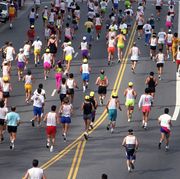This should seem obvious, but it needs repeating: Avoid eating a big meal too close to the start of your run. We have all heard about the importance of carb loading for runners, but a big plate of eggs benedict—even though it’s loaded with many necessary nutrients—is not going to feel so good sitting in your stomach.
It’s important to time your nutrition for best results. The digestive process slows down while we run and is unable to operate as usual because the normal blood flow to our gastro-intestinal (GI) system is diverted during exercise. (The diverted blood flow is redirected toward working muscles.) Therefore, if we eat a meal, especially a large one, food is not able to be digested normally, likely causing some sort of GI distress like cramping, side stitches, or worse.
If you are running first thing in the morning—for shorter runs—you may not even need to eat at all. Running on an empty stomach for runs less than an hour is pretty simple for most. However, if you are running later in the day, then it becomes increasingly important to watch your food intake. Allow at least one hour to pass after eating lunch or dinner before running (two hours may be better). Eating small meals or snacks throughout the day is one strategy to keep nutrition up and blood sugar levels stable.
Keep your food choices simple when you know a run is ahead, like lean protein and moderate carbohydrate content. These foods tend to be best because they are easily digestible. Avoid fried or fatty foods and overly sugary foods. Too much fiber can also prove to be a problem. For longer weekend morning runs, get up earlier and allow about 30 to 60 minutes digestion time before running. A small, easy-to-digest, pre-long run meal will help supply needed energy with a piece of toast with peanut butter and water. (Here is more on how to fuel those early-morning long runs.)
Everyone’s GI system is different, so be prepared to experiment with foods cautiously and figure out what works best for you given the time of day you will be running and the length of your run.


















